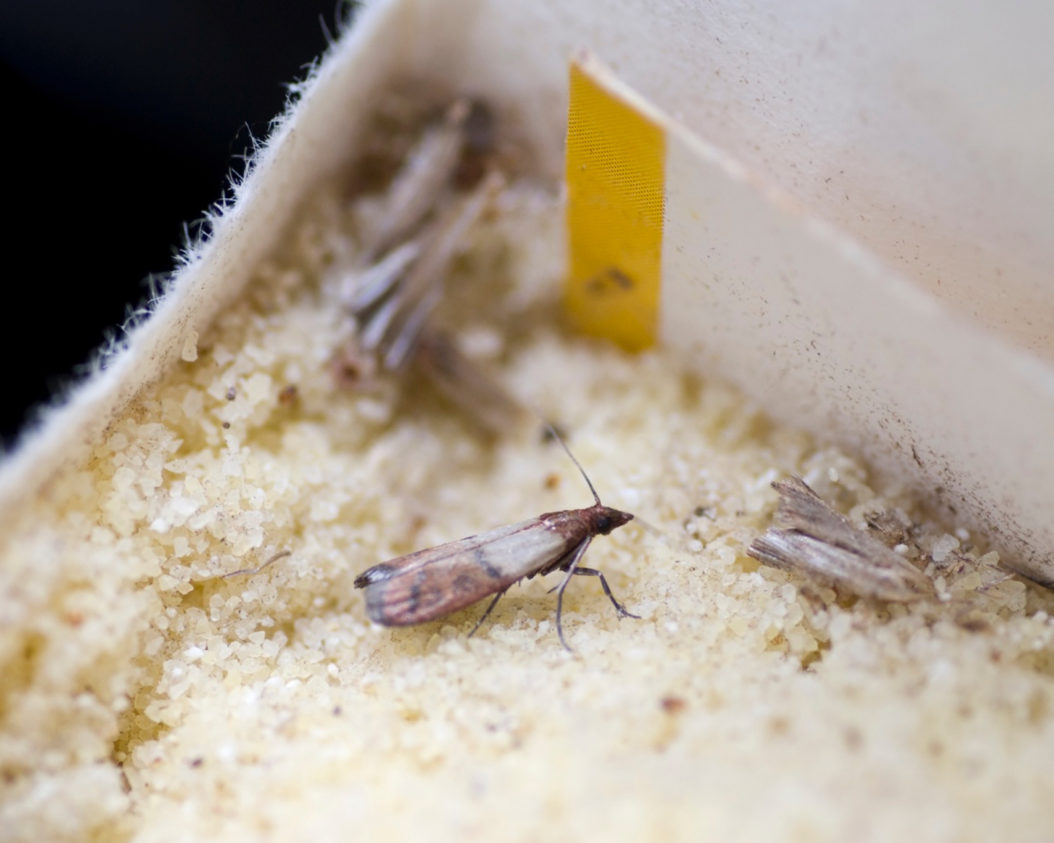Pantry moths
in chocolate.
What can I do?
The small pests do not stop in front of chocolate either
Text:
Katharina Kuhlmann
Photography:
istock Stephan Zabel
19 Juli 2018

Pantry moths in the larder are a nightmare for anyone with a household. These little pests are persistent and they like muesli, grain and similar – and like us, they also like chocolate and cocoa a lot. What are pantry moths, how can we protect us against them and what can we do when they already invaded our home? The VIVANI Chocolate Journal gives you the most important answers.
Pantry moths and their preferences
Like all so-called real moths, pantry moths belong to the butterfly family. This might sound nice in the beginning, but these insects are everything else than harmless flutter things. In comparison to the also bothersome clothes moth pantry moths don’t enjoy the taste of our textiles but they are aimed on nearly all food in our kitchen. Every species has their own preferences. The flour moth (Espestia kuehniella) is the main danger for our beloved chocolate. This storage pest has a size of about 11 to 14 mm, has a silvery-grey colour and lays its up to 500 (!) eggs in flour, grain products like muesli, bakery, legumes, almonds, nuts and, unfortunately, chocolate. The most common of the so-called pantry moths besides the flour moths are the meal moth (Pyralis farinalis) and the Indian meal moth (Plodia interpunctella), all of which belong to the butterfly family of the pyralid moths.
Pantry moths are usually introduced to the household without being noticed and are often found in products with defective packaging. They are famous for their hiding skills and can even bite through thin packaging and overcome the screw threads of storage glasses. They spread in the whole kitchen and storage area quickly because the caterpillars can creep up to 400 metres far. Creeping and jumping are the preferred means of moving for pantry moths because they can only fly short distances. But don’t worry, even if you are no manic for housework: a pantry moth infestation is not the result of cleaning too little.
Like butterflies, the moths develop from egg to larva to pupa to moth. The eggs are usually laid in the respective food that feeds the larvae. During pupation, the characteristic webs occur which cause the food to stick together and which are clear indicator for pantry moth infestation. The grown-up moths live for a maximum of two weeks and lay their eggs in food again – a vicious circle!
How to keep pantry moths away from your own kitchen
A certain amount of hygiene is important to keep pests away from your household. But as we mentioned before you can’t keep pantry months away by cleaning. We have a few tips how to prevent the little stock pests to move into your home.
You should always make sure only to buy food with intact packaging and complain about broken or affected goods to prevent the moths to spread. As soon as you’re home you should put your stock into airtight containers and store them in a cool and dry place. You should air your rooms regularly, we recommend using mosquito nets for your windows. Make sure you don’t offer hiding places for the moths by using lining paper and removing crumbs and dirt from your shelves regularly by cleaning them – don’t use a wet cloth because it builds a damp climate which helps the growth of pantry moths. Furthermore, you can “scent” your cabinets with essential oils to keep the pests way. You can use commercially available peppermint, lavender, patchouli, clove, thuja, cedar or potpourri.
Infestation with pantry moths – what can I do?
To break the vicious circle of constant reproduction of the pantry moths you have to pay attention to a few rules and take action accordingly. You should use sustainable methods instead of using hazardous pesticides.
After checking all (!) food and assessing your situation you should dispose of all affected food. In case of consumption of the webs and moth faeces you risk gastrointestinal disorders, skin problems and allergic reactions. It’s best to freeze the foul food for a few days or to heat it up for two hours at a maximum of 80 °C before disposal. This kills all pests and prevents them from spreading further.
All cabinets should be cleaned thoroughly, vacuumed and washed out with vinegar water, ideally you repeat this biweekly for a while. Dispose of your vacuum bag to be on the safe side. Cracks and areas which are difficult to access can be cleaned with a needle and/or treated with a hair dryer because heat harms or kills the pantry moths in their different stages. Fresh food should be stored in tightly closed containers to prevent a new outbreak.
You can also use beneficial insects to fight pantry moths. Ichneumon flies (Trichogramma evanescens), the natural enemies of pantry moths, are only 0,4 mm big insects, lay their eggs in pantry moth eggs and destroy them by doing so. They can be bought in stores on cards and are also available on the internet. Over a treatment period of 10 weeks online distributors send out the ichneumon flies several times, they perform their job barely visible for the house inhabitants. In case the infestation has ended they disappear by themselves. The only shortcoming: the treatment with ichneumon flies is pretty expensive with a price of 25 € up and is only worthwhile for strong infestation.
To control whether the pantry moths are gone you can buy pheromone traps. They contain a special pheromone that attracts the male pests which stick to the trap. In case no insects are caught you can tell the infestation is over.
Verwandte Artikel
Dziennik Czekoladowy
